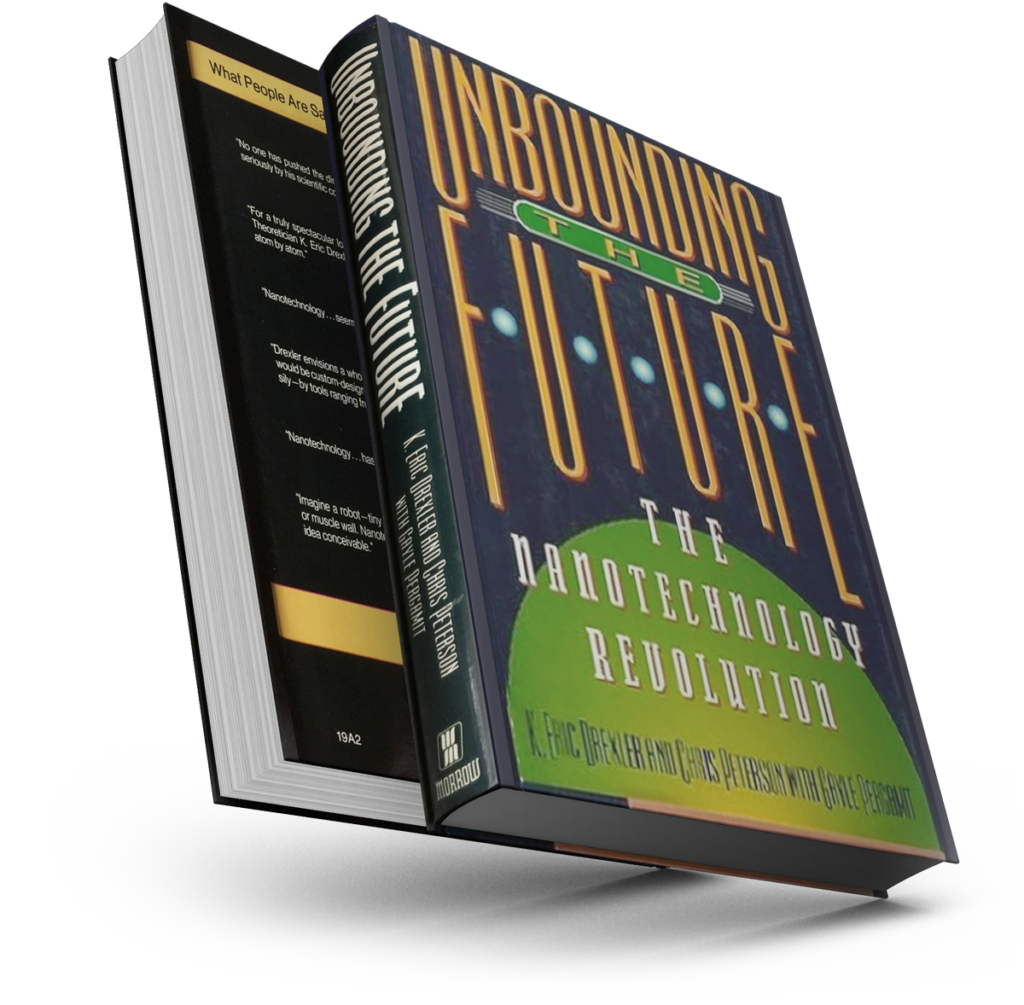
It’s impossible to give a complete bibliography of nanotechnology-related publications here. The following books, papers, and articles will lead readers into some of the relevant literatures; a more complete list is available from the Foresight Institute (address in Afterword).
DeGrado, William F., Zelda R. Wasserman, and James D. Lear, “Protein Design, a Minimalist Approach.” Science 243 (1989) 622-28. Describes successful work in protein design.
Drexler, K. Eric. “Molecular Engineering: An Approach of the Development of General Capabilities for Molecular Manipulation.” Proceedings of the National Academy of Sciences (USA) 78 (1981) 5275-78. First description of flexible molecular manufacturing based on artificial molecular machinery.
Drexler, K. Eric, and John S. Foster. “Synthetic tips.” Nature 343 (1990) 600. Proposes an approach to building a molecular manipulator.
Drexler, K. Eric. “Molecular Tip Arrays fir AFM Imaging and Nanofabrication.” Journal of Vacuum Science and Technology B. April 1991 (in press). An alternative approach to the goals described in “Synthetic Tips” aimed at sidestepping several technical problems and improving performance and flexibility.
Feynman, Richard. “There’s Plenty of Room at the Bottom,” a talk published in shorter form as “The Wonders that Await a Micro-microscope.” Saturday Review 43 (April 2, 1960) 45-47; reproduced at greater length under its original title in Miniaturization ed. H. D. Gilbert New York: Reinhold, 1961. The visionary talk sketches top-down miniaturization to the microscale, and points clearly in the direction of nanotechnology.
Foster, J. S., J. E. Frommer, and P. C. Arnett. “Molecular Manipulation Using a Tunneling Microscope,” Nature 331 (1988) 324-26. Describes the first use of an STM for bounding molecules to a large object.
Huse, William D.et al., “Generation of a Large Combinatorial Library of the Immunoglobulin Repertoire in Phage Lambda.” Science 246 (1989) 1275-81. Describes a method for generating protein molecules that bind other specific proteins by selecting from a large number of antibody fragments, without using mammalian cells.
Lehn, Jean-Marie. “Supramolecular Chemistry – Scope and Perspectives: Molecules, Supermolecules and Molecular devices.” Angewandte Chemie International Edition in English 27 (1988) 89-112. Describes work in molecular recognition (Lehn’s Nobel lecture).
Ponder, Jay W., and Frederic M. Richards. “Tertiary Templates for Proteins.” Journal of Molecular Biology 193 (1987) 775-91. Describes computer-based methods for choosing amino-acid sequences compatible with a given folded structure.
Alberts, Bruce, et al. Molecular Biology of the Cell, 2nd ed. New York: Garland Publishing, 1989. Describes natural molecular machinery.
Burkert, Ulrich, and Norma L. Allinger. Molecular Mechanics, ACS Monograph 177 Washington, D.C.: American Chemical Society, 1982. The classic text on modeling molecules in mechanical terms, based on relationships between energy and molecular geometry.
Clark, Tim. A Handbook of Computational Chemistry, New York: Wiley-Interscience, 1985. Describes the use of computer-based classical and (especially quantum mechanical models of molecules.
Crandall, B. C., and James Lewis, eds. Proceedings of the First Foresight Conference on Nanotechnology (working title). Cambridge, Mass.: MIT press, scheduled for the late 1991.
Creighton, Thomas E. Proteins. New York: W. H. Freeman, 1984. An excellent introduction to proteins as physical objects.
Drexler, K. Eric. Molecular Nanotechnology: Molecular Machines and Manufacturing (working title, book in progress as of 1991). Presents the physical principles of molecular machinery, with an analysis of a basic set of devices.
Published in 1992 as Nanosystems: Molecular Machinery, Manufacturing, and Computation. Reviews and ordering information.
Huberman, B. A. ed. The Ecology of Computation. Amsterdam: North-Holland/Elsevier Science Publishers, 1988. This collection includes three papers by Miller and Drexler presenting a market-based approach to organizing large-scale computation.
Maskill, Howard. The Physical Basis of Organic Chemistry. Oxford, Eng.: Oxford University Press, 1985. This is an unusual, useful textbook describing the chemistry of carbon-based molecules from the perspective of physical chemistry.
Rigby, Maurice, et al. The Forces Between Molecules. Oxford, Eng.: Clarendon Press, 1986. A good overview of its subject.
Finally, for those who object to attempt to explain nanotechnology to the public at this early stage, see the book How Superstition Won and Science Lost by John C. Burnham (New Brunswick, NJ: Rutgers, 1987). It describes how scientists have abdicated their responsibility in this area, and some of the consequences.
Audio and video tapes are available from the First Foresight Conference on Nanotechnology held in Palo Alto, California, in October 1989. Contact the Foresight Institute, P.O. Box 61058, Palo Alto, CA, 94306; telephone (415) 325-2490.
Description of current research projects in the Exploratory Research for Advanced Technology program (ERATO) are available from: Research Development Corporation of Japan, 5-2, Nagata-cho 2-chome, Chiyoda-ku, Tokio 100, Japan; fax 03-581-1486.
See also the nontechnical Further Reading section, and especially the Foresight Institute publications. Major advances in the enabling sciences are often published in the journals Science and Nature, both of which are worth browsing every week.